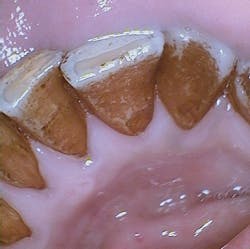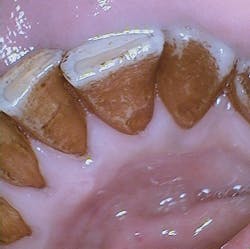Reduction of Tooth Stains: Patient education is vital to preventing tooth stain
BY NANCY W. BURKHART, BSDH, EdD
The patient in the image appearing with this column is scaled every four months because of the heavy stain on his teeth. Since he is a professional, he is very cognizant of his appearance when meeting with clients and makes certain that he arrives for his scheduled appointments.
George has stain on his teeth due to the fact that he drinks Darjeeling tea throughout the day, usually five to seven cups of strong tea. Darjeeling tea is highly flavored and is a favorite type of tea in India. It is often used in Chai tea that is popular in the United States as well.
With the popularity of major coffee houses, multiple beverage choices are constantly available to individuals, and these beverages usually contain either tea or coffee. Some choices include multiple shots of espresso with various sizes of the beverage from tall to vente. Additionally, the drinks are often flavored with dark caramel syrups, sprinkles, or other flavoring agents. Red wine connoisseurs also have more choices available to them through increased "happy hours" and availability of these wines served almost anywhere.
----------------------------------------------------
Other articles by Burkhart
- Oral Pemphigus and Pemphigoid: Why are these conditions so hard to diagnose?
- A dentist for all species: The Milwaukee zoo
- Have we forgotten palliative care? Debilitated patients still seek oral care
----------------------------------------------------
Dental offices must decide on whether to scale, polish, and/or air polish, as well as how often the procedures should be performed. Hygienists may consider more frequent appointments for patients who tend to build up stain before the standard time interval.
Some advantages of a two-month recare visit are:
1. Faster removal of stain
2. Less pressure from scaling procedures
3. A brighter, whiter smile for the patient
4. More time for patient education toward changing, adapting, or modifying lifestyle habits.
Coffee, for example, is very acidic, and this acidity allows more penetration into the tooth surface. Tea contains tannins that again allow the substance to adhere to the tooth and promote staining. The more tea consumed, the greater the stain and the faster the buildup. As teeth become more porous, stain buildup and discoloration may increase.
Tea, despite the staining on teeth, has actually been shown to reduce stress levels and promote a soothing sensation. Studies by Steptoe et al. (2007) in a randomized, double-blind study found that black tea consumption produced lower post-stress cortisol and greater subjective relaxation with reduced platelet activation. Since tea has been used for hundreds of years, the effect may be lingering and that is why the consumption throughout the day is thought to be beneficial to the individual.
Depending upon the amount and type of product, the staining can be heavy and more difficult to remove. Studies by Lee et al. (2014) found that adding milk to tea resulted in proteins as a component that would bind to the tannins in tea. This resulted in less staining of the teeth. For centuries, the English have added milk to their tea so the concept is not new. What is new in the Lee study, however, is that there is scientific evidence that the composition of the product is somewhat altered and may decrease the amount of stain (and it is tasty too!). The authors do cite some previous studies indicating that the antioxidant benefits of the tea may be altered during the process and that the tea may not provide the protective cardiovascular aspect. However, further research is needed.
Many food and beverages that also stain teeth do provide substantial nutritional value to the individual as well. Blueberries and beets are known for their high pigmentation and staining ability (see sidebar).
Touyz (2009) reported the beneficial properties and also negative effects of licorice and its ability to inhibit the conversion of cortisol to cortisone by inhibiting the enzyme 11-betahydroxysteroid dehydrogenase. He reported a case of a patient who was treated for hypertension unsuccessfully for several years. The patient had oral staining and had consumed black licorice (200-250 g) daily after completing smoking cessation several years previously. Licorice has been recognized as having tooth- and tongue-staining ability due to the color additives. In addition, the polysaccharide from microbial activity contributes to the biofilm formation and bacterial plaques.
The article touts the fact that licorice has been used in medicine for hundreds of years. On the more beneficial side, the product does have some antiviral and antibacterial properties. Licorice may be found in chewing tobacco, pipe tobacco, snuff products, cough syrup, cough lozenges, various medicines, candies, chewing gum, chocolates, baked goods, and some alcoholic drinks, especially in France, Holland, and other areas of Europe. Touyz cautions health-care workers to ask patients who have hypertension or if a history of diuretics is noted, to inquire about licorice use.
So how does the dental professional advise the patient to counteract the staining of these types of foods and beverages? Patients have begun to realize the benefits of eating more fruits and vegetables along with the benefits realized from coffee as well as tea.
Tips for patients when reducing stain on teeth
• Use a straw when drinking juices or liquids that stain the teeth.
• Add milk to tea/coffee to lessen the stain of the product.
• Rinse with clear water after eating or drinking a highly pigmented food or drink.
• Eat raw, crunchy type vegetables throughout the day.
• Some teas may stain more than others, changing to a less staining type such as white tea can decrease the stain.
• Hard cheeses may add a protective element to the teeth in fighting stains.
• Drinking hot water with lemon or flavors added to hot water such as fennel seeds, coriander, and cumin (placed in a tea ball) can provide some of the same calming sensations as tea.
• The patient who drinks tea throughout the day might consider drinking tea followed by warm water with lemon for the next cup or perhaps a light herbal tea.
• Chewing gum with xylitol may diminish the stain by stimulating saliva to cleanse the mouth.
• Using a tongue cleaner to remove the residue on the tongue and in the papillae. The stain is continually bathing the teeth when left in the papillae. Using a tongue cleaner several times a day is optimal.
• Specific instruction in brushing and flossing for the individual patient is necessary and may include an electric toothbrush as well as a manual brush along with an appropriate type of toothpaste that is recommended for the individual patient.
In the case presented within this article, the patient is a heavy tea drinker who would need to be scaled and polished frequently in order to diminish the appearance of stains. According to Wilkins (2013), polishing teeth with abrasive prophylaxis paste will remove a few millimeters of the outer layer of enamel and the justification for using the least abrasive prophylaxis paste is suggested for stain removal, and especially, when more frequent dental visits are necessary. A cleaning agent product (polishing agent vs. cleaning agent) will prevent the fluoride-rich outer surface of the enamel to be somewhat preserved.
The air-power polishing is recommended favorably for stain and biofilm removal. Patient contraindications are sodium restricted diets (when using air-polishers with sodium bicarbonate powder), respiratory issues, end-stage renal disease, Addison's disease or Cushing's disease, immunocompromised patients, and patients taking potassium, antidiuretics, or steroid therapy.
Assisting the patient in limiting the number of visits and frequency of scaling will decrease the amount of possible enamel abrasion. The tips provided may furnish the patient with some control over and management of the stain on his/her teeth.
As always, continue to ask good questions and always listen to your patients. I would like to recognize Carol Perkins, RDH, for her advice about foods that stain within this article. RDH
Foods/Products that Stain Teeth 1. Extrinsic: Foods, beverages, and tobacco products2. Intrinsic products:
Foods that Naturally Whiten Teeth The ability of crunchy types of vegetables and fruits provide some friction that acts as a cleaning mechanism and inhibits stain. Certain fruits and dairy products may also be acidic and inhibit stain. The acidity may cause enamel loss over time, so careful selection of fruits is suggested.
|
References:
1. DeLong L, Burkhart NW. (2013) General and Oral Pathology for the Dental Hygienist. 2nd ed. Baltimore MD: Wolters Kluwer Health, Lippincott Williams & Wilkins.
2. Steptoe A, Gibson EL, Vuononvirta R, Williams ED, Hamer M, Rycroft JA, Erusalimsky JD, Wardle J. The effects of tea on psychophysiological stress responsivity and post-stress recovery: a randomised double-blind trial. Psychopharmacology. 2007 190:1: 81-89.
3. Touyz LZG. Liquorice health check, oro-dental implications, and a case report. Case Rep Med; 2009:170735. doi 10.1155/2009/170735. Epub 2009 Jul 8.
4. Wilkins EM. (2013) Clinical Practice of the Dental Hygienist 11th ed. Philadelphia PA: Wolters Kluwer Health, Lippincott Williams & Wilkins.
NANCY W. BURKHART, BSDH, EdD, is an adjunct associate professor in the department of periodontics, Baylor College of Dentistry and the Texas A & M Health Science Center, Dallas. Dr. Burkhart is founder and cohost of the International Oral Lichen Planus Support Group (http://bcdwp.web.tamhsc.edu/iolpdallas/) and coauthor of General and Oral Pathology for the Dental Hygienist. She was a 2006 Crest/ADHA award winner. She is a 2012 Mentor of Distinction through Philips Oral Healthcare and PennWell Corp. Her website for seminars on mucosal diseases, oral cancer, and oral pathology topics is www.nancywburkhart.com.

